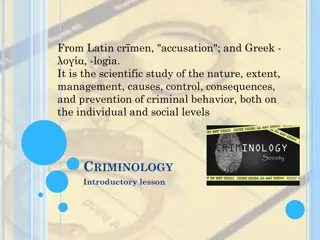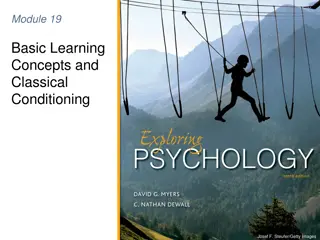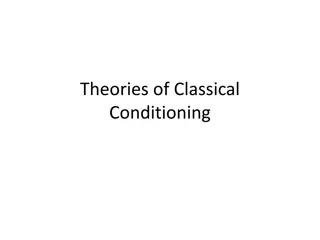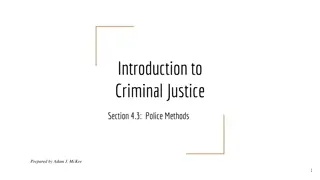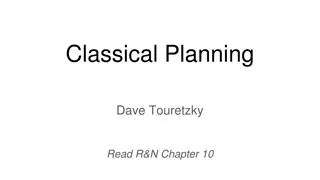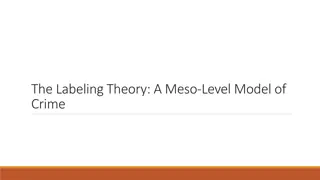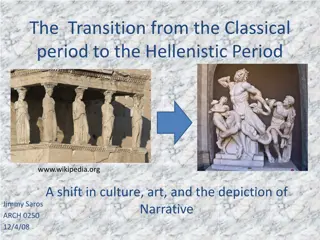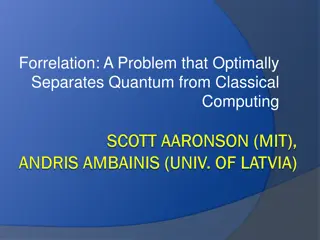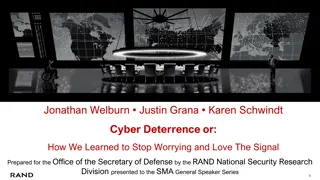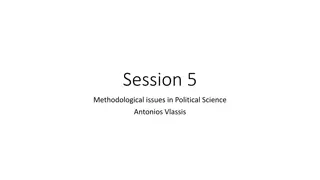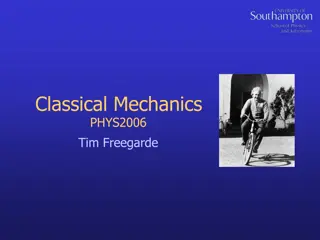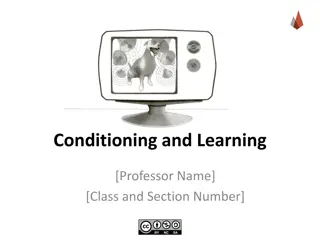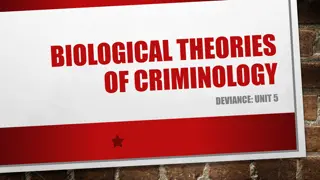Understanding Deterrence Theory and Classical Criminology
The content provides an overview of deterrence theory, focusing on key figures, assumptions, general and specific deterrence, research, and policy implications. It also delves into classical criminology, discussing key figures like Jeremy Bentham and Cesare Beccaria, concepts such as felicity calculus, and insights on why people choose to break the law. The material provides a historical context along with modern perspectives on crime control.
Download Presentation

Please find below an Image/Link to download the presentation.
The content on the website is provided AS IS for your information and personal use only. It may not be sold, licensed, or shared on other websites without obtaining consent from the author. Download presentation by click this link. If you encounter any issues during the download, it is possible that the publisher has removed the file from their server.
E N D
Presentation Transcript
OVERVIEW OF DETERRENCE LECTURE Handout: Assessing the impact of the great prison experiment on future crime control Handout: Assessing the impact of the great prison experiment on future crime control policy, policy, Federal Probation Federal Probation ( Dec. 2013) ( Dec. 2013) Other reading: See Schedule for week 2. Other reading: See Schedule for week 2. Deterrence theory in a nutshell: Deterrence theory in a nutshell: 1. 1. Key Figures Key Figures 2. 2. Key assumptions Key assumptions 3. 3. General Deterrence General Deterrence 4. 4. Specific Deterrence Specific Deterrence 5. 5. Deterrence theory, research, and policy Deterrence theory, research, and policy
A BRIEF HISTORY OF CLASSICAL CRIMINOLOGY Key Figures: Key Figures: Jeremy Bentham: utilitarianism, felicity calculus, Jeremy Bentham: utilitarianism, felicity calculus, panopticon panopticon prison prison Cesare Beccaria: Cesare Beccaria: On Crimes and Punishments (1763): On Crimes and Punishments (1763): originally published anonymously; belonged to a reform group, the academy of fists anonymously; belonged to a reform group, the academy of fists originally published James Q. Wilson: Conservative James Q. Wilson: Conservative criminology, criminology,Thinking Thinking About Crime About Crime http://frontrow.bc.edu/program/wilson1/ http://frontrow.bc.edu/program/wilson1/ Cohen and Cohen and Felson Felson : Routine Activities Theory : Routine Activities Theory https://www.youtube.com/watch?v=ia9S6ZDSzTc https://www.youtube.com/watch?v=ia9S6ZDSzTc Ron Clark: Rational Choice and Situational Crime Control Ron Clark: Rational Choice and Situational Crime Control
FELICITY CALCULUS Jeremy Bentham thought any individual could determine the utility of an action. Bentham was one of the first proponents of Utilitarianism. According to Bentham, The Calculus of Felicity is a series of questions an individual should consider when evaluating the happiness an action will yield. Intensity - How intense is the happiness? Duration - How long will the happiness last? Certainty - How sure is the individual that the action will make them happy? Propinquity - How soon will the individual be happy? Fecundity - Will the action produce even more pleasure? Purity - How free from pain is the happiness? Extent - How many people are affected by this action? https://www.youtube.com/watch?v=yOT-IfUzOwk
INSIDE BENTHAMS PANOPTICON PRISON https://www.youtube.com/watch?v=WnD216zoDng https://www.youtube.com/watch?v=WnD216zoDng
WHY DO PEOPLE DECIDE TO BREAK THE LAW? To a classical criminologist, the answer is simple: the To a classical criminologist, the answer is simple: the benefits money, property, revenge, status, etc.) simply outweigh the potential money, property, revenge, status, etc.) simply outweigh the potential costs/consequences costs/consequences of getting caught and convicted. of getting caught and convicted. benefits of law breaking (i.e. of law breaking (i.e. When viewed from a classical perspective, we are all capable of committing crime in When viewed from a classical perspective, we are all capable of committing crime in a given situation; a given situation; but we make a rational decision (to act or desist) based on our analysis of the costs but we make a rational decision (to act or desist) based on our analysis of the costs and benefits of the action. and benefits of the action. If this is true, then it is certainly possible to If this is true, then it is certainly possible to deter developing a system of "sentencing" in which the punishment outweighed the developing a system of "sentencing" in which the punishment outweighed the (benefit of the) crime, and (2) insuring both punishment certainty and celerity via (benefit of the) crime, and (2) insuring both punishment certainty and celerity via efficient police and court administration. efficient police and court administration. deter a potential offender by (1) a potential offender by (1)
THREE UNDERLYING ASSUMPTIONS OF DETERRENCE THEORY Certainty: Certainty: apprehension, charging, convicting Celerity: Celerity: speed of justice system response Severity: Severity: level of punishment System Applications: System Applications: During the past three decades, a number of federal, state and local programs have been initiated to improve the deterrent capacity of the criminal justice system, including : proactive police strategies to insure greater certainty of apprehension, priority prosecution/speedy trial strategies to insure greater celerity (speed) in the court process, and determinate/mandatory sentencing strategies to insure greater punishment severity. Q. What is the clearance rate for major index crimes? Q. What is the clearance rate for major index crimes? Q. For discussion: Is there a deterrence tipping point? Q. For discussion: Is there a deterrence tipping point?
DETERRENCE THEORY AND CRIMINAL JUSTICE POLICY Theoretical Assumptions Theoretical Assumptions Intervention Strategy Intervention Strategy Examples of Examples of Programs/Strategies Programs/Strategies Mandatory Sentencing and Mandatory Sentencing and Sentencing Guideline Sentencing Guideline Schemes Schemes Individuals are rational and Individuals are rational and weigh the costs and weigh the costs and benefits of their actions benefits of their actions similarly similarly Individuals will be deterred Individuals will be deterred from committing criminal from committing criminal acts if the costs of the acts if the costs of the illegal activity outweighs the illegal activity outweighs the benefit of the activity in the benefit of the activity in the mind of the potential mind of the potential offenders offenders General and Specific Deterrence Establish clear links between illegal behavior and consequences, utilizing sanctions that include loss of freedom, loss of rights and privileges, drug testing, and/or mandatory work, community service, fines, and treatment Community corrections Community corrections personnel will monitor personnel will monitor compliance with conditions compliance with conditions of supervision, and respond of supervision, and respond quickly, consistently to any quickly, consistently to any detected violations, utilizing detected violations, utilizing a structured hierarchy of a structured hierarchy of sanctions linked to the sanctions linked to the seriousness of the seriousness of the violation(s). violation(s). The use of either judicially The use of either judicially imposed or administratively imposed or administratively imposed special conditions imposed special conditions of Probation and Parole of Probation and Parole Supervision Supervision There are three components There are three components of the deterrence of the deterrence calculus(1) certainty of calculus(1) certainty of detection and detection and apprehension, (2) apprehension, (2) speed/celerity of the speed/celerity of the criminal justice system s criminal justice system s sanction, and (3) severity of sanction, and (3) severity of the sanction imposed for the sanction imposed for each prohibited act each prohibited act *Day Reporting Centers *Day Reporting Centers *Intensive Supervision *Intensive Supervision Programs Programs *Electronic Monitoring/ *Electronic Monitoring/ Home Confinement Home Confinement Programs Programs
RESEARCH TESTING KEY DETERRENCE THEORY ASSUMPTIONS Research on General Deterrence: Research on General Deterrence: Police Police: Levitt (1997) found that a 10 percent increase in the size of a city s police force was associated with an 11 percent lower violent crime rate and a 3 percent lower property crime rate (using county-level data); however, other more recent analyses and reviews(Bradford, 2012) suggest that increasing police force size will have no impact on the violent crime rate, and only marginal improvement (1-3%) in property crime rates. Incarceration: Incarceration: Research shows that increases in incarceration account for approximately 25% of the overall crime decline since 1980s. Effects reported in sophisticated research studies reveal a small overall incarceration effect, with some arguing that a certain tipping point, higher rates of incarceration actually increase crime rates in high risk communities, likely due to loss of guardianship, and fewer adult males in community.
OTHER COMMUNITY LEVEL FACTORS LINKED TO CRIME Employment Employment: According to several studies(Levitt, 1996; Levitt, 1997; Raphael & Winter- Ebmer, 2001; Gould et al., 2002), a 10 percentdecrease in the state s unemployment rate corresponded with a 10 16 percent reduction in property crime, but had no effect on violent crime (state and county-level data); Income Income: a 10 percent increase in real wages was associated with a 13 percent lower index crime rate, a 12 percent lower property crime rate, and a 25 percent lower crime rate at the national level (Gould et al., 2002); state-level analyses identified a 16 percent lower violent crime rate (Raphael and Winter-Ebmer, 2001); and individual-level analyses reveal that a 10 percent increase in real wages is associated with a 10 percent decrease in crime participation (Grogger, 1998); Education Education: a one-year increase in the average education level of citizens resulted in a 1.7 percent lower index crime rate, while a 10 percent increase in graduation rates resulted in a 9.4 percent reduction in the index crime rate and a 5-10 percent reduction in arrest rates, through the increased wages associated with graduation
RESEARCH TESTING KEY DETERRENCE THEORY ASSUMPTIONS Research on Specific Deterrence: Research on Specific Deterrence: a careful review of the evaluation research on the latest wave of deterrence-oriented community-based sanctions does not support the notion that increased surveillance and control reduces recidivism (e.g. an offender's likelihood of re-arrest). Key Research Key Research :Of the six studies identified by Nagin (2013), only two reported significant specific deterrent effects associated with the increased certainty of punishment: Weisburd, Einat, and Kowalski (2008) focused on the problem of delinquent fines, while the Kleiman study (2009) examined the problem of drug-test failures. Both of these studies examined the impact of increasing punishment certainty on the level of compliance among probationers, and both studies identified significant effects linked directly to the certainty of punishment.
IMPLICATIONS FOR POLICY: BAD THEORY OR BAD RESEARCH? There are two possible explanations for these findings: (1) the underlying assumptions of classical criminologists (i.e. most people are rational, and weigh the costs and benefits of various acts in the same manner) are wrong(e.g. people commit crimes for emotional reasons, because of mental illness, and/or because they believe the criminal act is justified, given circumstances and prevailing community values ); or (2) the current programs need to be even tougher and deterrence-oriented (in other words, the theory is correct; it just has not been implemented correctly).
MORE RECENT NEO CLASSICAL APPLICATIONS: Cohen and Cohen and Felson s Felson s Routine Activities Theory Routine Activities Theory Ron Clarke s Rational Choice Theory and Situational Crime prevention Ron Clarke s Rational Choice Theory and Situational Crime prevention Focus on changing the situational context of crime: reduce crime by changing the Focus on changing the situational context of crime: reduce crime by changing the environment in meaningful ways. environment in meaningful ways. Crime Crime- -specific recommendations for situational crime prevention are provided by specific recommendations for situational crime prevention are provided by Clarke and colleagues. Clarke and colleagues. http://www.popcenter.org/ http://www.popcenter.org/
REVIEW OF NEOCLASSICAL APPROACH Roots in classical school (1750 Roots in classical school (1750- -1850) Commonality = humans as rational calculators Renewed interest 1970s-present Fit with conservative ideology 1850) Deterrence Rational Choice Routine Activities
ROUTINE ACTIVITIES THEORY (COHEN AND FELSON) Crime as the Convergence Crime as the Convergence in Time and Space of in Time and Space of Three Factors Three Factors 1. Motivated Offenders 2. Suitable Targets 3. Lack of Capable Guardianship Scope: Direct Scope: Direct- -Contact Predatory Crimes Predatory Crimes Felson in 1990s extended to white collar crime, drug crime Contact
COMPONENTS OF A CRIMINAL EVENT
KEY ASSUMPTIONS Routine patterns of work, play, and leisure time affect Routine patterns of work, play, and leisure time affect the convergence in time and place of motivated the convergence in time and place of motivated offenders who are not handled, suitable targets, and offenders who are not handled, suitable targets, and the absence of guardians the absence of guardians If one component is missing, crime is not likely to be If one component is missing, crime is not likely to be committed. committed.
SITUATIONAL CRIME CONTROL: RON CLARKE Ron Clarke: Stockholm Prize Winner, 2015 Ron Clarke: Stockholm Prize Winner, 2015 https://www.youtube.com/watch?v=edjQXd0FmfE https://www.youtube.com/watch?v=edjQXd0FmfE Application: Bank Robbery Application: Bank Robbery http://www.popcenter.org/problems/robbery_banks/ http://www.popcenter.org/problems/robbery_banks/
EXAMPLES OF SITUATIONAL CRIME PREVENTION (RONALD CLARKE) Increase the perceived effort of crime Increase the perceived effort of crime Target hardening (better window locks) Control access to targets (electronic access to parking garage) Increase perceived risks of crime Increase perceived risks of crime Natural surveillance (street lights, defensible space) Formal surveillance (red light/speed cameras) Reduce anticipated rewards of crime Reduce anticipated rewards of crime Reduce targets (removable car radios, women s refuges) Deny benefits (prompt graffiti cleaning)
EXAMPLES OF SITUATIONAL CRIME PREVENTION (RONALD CLARKE) Technique Increase the effort for crime Harden targets Examples Steering column locks, tamper- proof packaging Electronic access to garages Smart guns, plastic beer glasses in taverns Control access to facilities Control tools/weapons Increase the risks of crime Extend guardianship Travel in groups at night, carry a phone Street lighting, defensible space Two clerks in convenience stores Burglar alarms, security guards Assist natural surveillance Utilize place managers Strengthen formal surveillance
EXAMPLES OF SITUATIONAL CRIME PREVENTION II Technique Reduce Reward Remove targets Examples Removable car radios, women s refuges Property marking, cattle branding Identify property Reduce Provocations Reduce emotional arousal Avoid disputes Controls on violent pornography Fixed cab fares, reduce crowding in bars Remove Excuses for Crime Set rules Control drugs/alcohol Rental agreements, hotel registration Breathalyzers in bars, alcohol-free events




